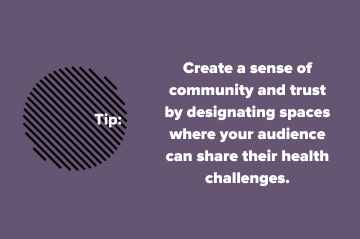Kobe Campbell, Bryce Spencer-Jones, Lindsay Fleming, Rachel Havekost, Khalida Himes, Sasha Hamdani, Patrice Berry, Jaime Mahler, and Divija Bhasin are all accomplished mental health content creators. Collectively, these nine creators reach millions of followers that trust them to share health information from their professional and personal expertise. They shared the following tips on building audience trust with Elissa Scherer (a Center for Health Communication Student Advisor Board member) at Harvard Chan School’s Creators Summit on Mental Health.
Tip #1: Be transparent about your expertise: Openly share your qualifications and background to build credibility. Demonstrating transparency about your expertise lays the foundation for trust.
Tip #2: Make it clear you are here to educate: Explicitly state that your content is designed to offer educational insights, serving as a supplementary resource rather than a substitute for personalized medical advice. Encourage your audience to seek individualized guidance from healthcare professionals as needed.
Tip #3: Be real: Sharing personal experiences allows you to connect with your audience on a relatable level. If you are comfortable sharing your experiences, it can help establish you as someone who understands the issue on a personal level. However, it’s essential to remember to clarify that your experiences are not universal and are not a replacement for qualified medical advice.
Tip #4: Build supportive spaces: Create a sense of community and trust by designating spaces where your audience can share their health challenges. Those spaces could include “live chats” on Instagram or TikTok or Zoom support groups. Whatever platform you use, make sure to clearly define what information you are comfortable providing to your audience to ensure respectful and safe interactions (e.g., that you will not be offering individualized advice).
Tip #5: Provide encouraging responses: Responding to audience questions and comments with encouraging and informative content reinforces your dedication to their health journey. This could be in the form of responding to comments or “stitching” a video they made to provide more information. Here’s how creator Sasha Hamdani uses stitching to engage on TikTok.
Tip #6: Make a library of reliable information: Direct your audience to reliable sources of information about key topics in your area. You can compile these resources on a Linktree. Here’s how creator Patrice Berry uses this tool as a resource library. By offering your page as a source for credible references, you build trust and empower your audience to make informed decisions.
Tip #7: Promote and model self-care: Demonstrate the importance of self-care during challenges by explaining how you are taking care of yourself and encourage others to do the same. This showcases your empathy and dedication to your well-being and your audience’s well-being.
Tip #8: Be an active listener: When you receive audience feedback, make sure to actively engage and listen without defensiveness. Engaging with audience feedback without defensiveness enhances your content and demonstrates your receptiveness to your audience’s needs.
Tip #9: Learn from perspectives that challenge you: Continuously enrich your understanding by seeking knowledge from diverse leaders. Demonstrating your dedication to ongoing growth showcases your commitment to effectively serving diverse audiences.
Tip #10: Use culturally responsible language: Engage with resources to ensure that the language you use respects diverse cultures, identities, and backgrounds. Using inclusive language in your content helps you connect with a broader audience.
Tip #11: Address sensitive topics: Engage in open discussions about sensitive topics like racism, transphobia, homophobia, misogyny, body-shaming, or ableism. This showcases your commitment to breaking down barriers and providing accurate information.
Tip #12: Amplify diversity: Highlighting diverse voices and experiences promotes inclusivity. Ensuring several perspectives are represented fosters a sense of belonging and trust among your audience.
Tip #13: Acknowledge privilege and foster growth: Recognize any privileged identities you may possess and how they shape your perspective. Openly embrace willingness to learn from errors you may make in communicating. Recognizing where you are coming from and mistakes you make nurtures an environment of authenticity and trust.
Building trust in health content requires dedication to accuracy, transparency, and an understanding of the diverse needs of your audience. By following the tips outlined in this guide, you’ll be better equipped to provide valuable health insights, offer meaningful support, and foster an inclusive environment that respects the unique needs of your diverse audience.




